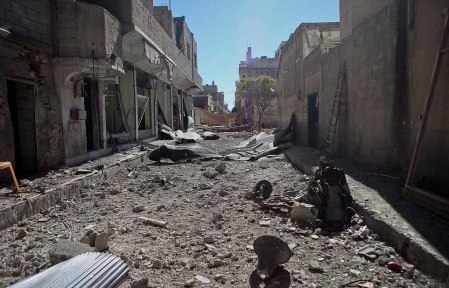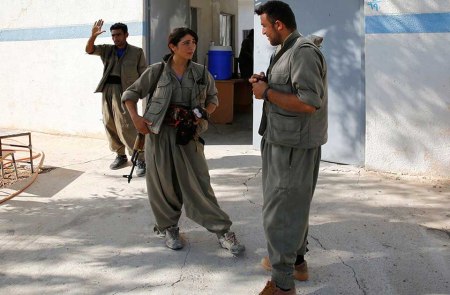The Kurdish defenders of Kobane draw pride from holding out against an overwhelming force of IS (Islamic State) terrorists, which are blatantly supported by Turkey. On December 23 it were 100 days since the attack began.
Most of the eastern areas of the town have been destroyed, but the western side has been spared much of the intense fighting between the YPG (Kurdish People’s Protection Unit) and IS.
There are still a fair number of civilians left in the city. In the streets of western Kobane children run around and play as if nothing unusual is happening. Many of the people who stayed have joined the YPG forces to help defend their town against IS.
As fearless and calm as the inhabitants of the town might look, Kobane is still a very dangerous place. On December 16 three civilians were killed by IS mortars which regularly fall in and around Kurdish-controlled areas. That morning, a father, his son, and their neighbor became victims of the senseless aggression. The father, Ahmed Abud, was an Arab man married to a Kurdish woman. After IS overran his village, he had sought refuge in Kobane. He is survived by his wife and a daughter who are still in the town.
“He was a very good man. We used to help each other in moments of need,” said Abu Yasin, another one of Abud’s neighbors. “He wanted to go back to his village once it was liberated.”
On the streets of Kobane there are craters everywhere, unexploded rocket shells and mortars are lying around. One particular type built by IS terrorists is called the Hell Mortar. It is made from a large gas capsule, used in this part of the world for cooking, soldered to a long pipe fitted with a multi-bladed tail.

The confrontation between Kurdish forces and IS has brought this once-unknown town in northeastern Syria worldwide attention. The feeling of pride is ubiquitous. Kurdish fighters and civilians alike boast how their small town has held fast against the terror organizations mighty military machine and brutal campaign for more than three months. Their fierce resistance is in stark contrast to many other areas in Iraq and Syria that fell to the militants in a matter of days without much resistance.
The sound of US fighter jets overhead is a constant feature of life in Kobane. On the night of December 14, US fighter jets carried out 12 rounds of strikes in response to an operation by IS to break through YPG lines on the eastern and southern fronts, the scene of the heaviest fighting in recent weeks.

In addition to YPG fighters, there are also a few units of the Iraqi Kurdish peshmerga and the FSA (Free Syrian Army) stationed in Kobane. The peshmerga are mostly deployed to the rear lines, acting as a support unit. When IS starts launching mortars or other types of attacks, the peshmerga can be heard firing their own mortars, canons and Doushkas, Russian-made heavy machine guns. One occasionally sees FSA fighters on the streets. Local officials claim that only one FSA group, the Northern Sun Battalion, is playing an active role in the fighting.
One particular location of interest in Kobane is the official crossing with Turkey, the Mursitpinar border gate. It was the site of heavy fighting between Kurdish forces and IS militants on November 29, starting at around 6 am, when a suicide bomber drove an armored military vehicle through the gate and detonated it. The large crater and the heavy destruction caused by the vehicle and some of its remnants are testimony to the magnitude of the incident.
Some senior YPG commanders were apparently sleeping in a nearby building that night, and their presence helped with a swift response to IS’ attempt to infiltrate Kobane from the north. After nearly 15 hours of clashes, Kurdish forces pushed the IS fighters back, preventing them from crossing into the town.
Kurdish officials in Kobane are still baffled by what happened and condemn Turkey for facilitating the passage of IS fighters through its side of the border. Video of the fighting and the scene at the border gate appear to strongly support Kurdish claims that the IS operation indeed originated from the Turkish-controlled side of the Mursitpinar gate. Turkish officials have denied that the terrorists used their territory for this attack.
“We knew Turkey was lenient with IS, but we could not believe they would go so far as allowing them to cross their territory to attack us,” said Ismat Sheikh Hassan, the defense minister of the local government in Kobane. “We do not know if this was done with the consent of the senior levels of Turkish government or just some local officials.” Hassan also said YPG forces subsequently occupied the grain silos and some buildings on the Turkish side of the border and only agreed to evacuate them after Turkish soldiers returned to their posts.
Kurdish fighters have been able to score gains against IS in recent weeks. US coalition airstrikes and the peshmerga’s deployment have played a role in boosting the YPG’s offensive and defensive capabilities. Morale appears to be high among the Kurdish fighters. They are optimistic that they will be able to reclaim the town, but taking the broader Kobane area of some 400 villages is a long way off and will be a difficult undertaking.
In addition to Syrian Kurdish fighters, there are also many Kurdish fighters from Turkey among the YPG’s ranks, along with foreign fighters from Iran and Algeria. Erdal, a 19-year-old Kurd from Turkey, who at the moment wears a bandage on his neck to protect a small shrapnel wound from a mortar, smiles as he speaks: “IS beheads people to scare their enemies. It’s psychological warfare. They want to make their enemies run away,” and he proudly states: “But they don’t scare us. We have proven they are not as strong as they claim. If we were afraid, we could not have stood here and fought them for so long.”

Most of the eastern areas of the town have been destroyed, but the western side has been spared much of the intense fighting between the YPG (Kurdish People’s Protection Unit) and IS.
There are still a fair number of civilians left in the city. In the streets of western Kobane children run around and play as if nothing unusual is happening. Many of the people who stayed have joined the YPG forces to help defend their town against IS.
As fearless and calm as the inhabitants of the town might look, Kobane is still a very dangerous place. On December 16 three civilians were killed by IS mortars which regularly fall in and around Kurdish-controlled areas. That morning, a father, his son, and their neighbor became victims of the senseless aggression. The father, Ahmed Abud, was an Arab man married to a Kurdish woman. After IS overran his village, he had sought refuge in Kobane. He is survived by his wife and a daughter who are still in the town.
“He was a very good man. We used to help each other in moments of need,” said Abu Yasin, another one of Abud’s neighbors. “He wanted to go back to his village once it was liberated.”
On the streets of Kobane there are craters everywhere, unexploded rocket shells and mortars are lying around. One particular type built by IS terrorists is called the Hell Mortar. It is made from a large gas capsule, used in this part of the world for cooking, soldered to a long pipe fitted with a multi-bladed tail.

The confrontation between Kurdish forces and IS has brought this once-unknown town in northeastern Syria worldwide attention. The feeling of pride is ubiquitous. Kurdish fighters and civilians alike boast how their small town has held fast against the terror organizations mighty military machine and brutal campaign for more than three months. Their fierce resistance is in stark contrast to many other areas in Iraq and Syria that fell to the militants in a matter of days without much resistance.
The sound of US fighter jets overhead is a constant feature of life in Kobane. On the night of December 14, US fighter jets carried out 12 rounds of strikes in response to an operation by IS to break through YPG lines on the eastern and southern fronts, the scene of the heaviest fighting in recent weeks.

In addition to YPG fighters, there are also a few units of the Iraqi Kurdish peshmerga and the FSA (Free Syrian Army) stationed in Kobane. The peshmerga are mostly deployed to the rear lines, acting as a support unit. When IS starts launching mortars or other types of attacks, the peshmerga can be heard firing their own mortars, canons and Doushkas, Russian-made heavy machine guns. One occasionally sees FSA fighters on the streets. Local officials claim that only one FSA group, the Northern Sun Battalion, is playing an active role in the fighting.
One particular location of interest in Kobane is the official crossing with Turkey, the Mursitpinar border gate. It was the site of heavy fighting between Kurdish forces and IS militants on November 29, starting at around 6 am, when a suicide bomber drove an armored military vehicle through the gate and detonated it. The large crater and the heavy destruction caused by the vehicle and some of its remnants are testimony to the magnitude of the incident.
Some senior YPG commanders were apparently sleeping in a nearby building that night, and their presence helped with a swift response to IS’ attempt to infiltrate Kobane from the north. After nearly 15 hours of clashes, Kurdish forces pushed the IS fighters back, preventing them from crossing into the town.
Kurdish officials in Kobane are still baffled by what happened and condemn Turkey for facilitating the passage of IS fighters through its side of the border. Video of the fighting and the scene at the border gate appear to strongly support Kurdish claims that the IS operation indeed originated from the Turkish-controlled side of the Mursitpinar gate. Turkish officials have denied that the terrorists used their territory for this attack.
“We knew Turkey was lenient with IS, but we could not believe they would go so far as allowing them to cross their territory to attack us,” said Ismat Sheikh Hassan, the defense minister of the local government in Kobane. “We do not know if this was done with the consent of the senior levels of Turkish government or just some local officials.” Hassan also said YPG forces subsequently occupied the grain silos and some buildings on the Turkish side of the border and only agreed to evacuate them after Turkish soldiers returned to their posts.
Kurdish fighters have been able to score gains against IS in recent weeks. US coalition airstrikes and the peshmerga’s deployment have played a role in boosting the YPG’s offensive and defensive capabilities. Morale appears to be high among the Kurdish fighters. They are optimistic that they will be able to reclaim the town, but taking the broader Kobane area of some 400 villages is a long way off and will be a difficult undertaking.
In addition to Syrian Kurdish fighters, there are also many Kurdish fighters from Turkey among the YPG’s ranks, along with foreign fighters from Iran and Algeria. Erdal, a 19-year-old Kurd from Turkey, who at the moment wears a bandage on his neck to protect a small shrapnel wound from a mortar, smiles as he speaks: “IS beheads people to scare their enemies. It’s psychological warfare. They want to make their enemies run away,” and he proudly states: “But they don’t scare us. We have proven they are not as strong as they claim. If we were afraid, we could not have stood here and fought them for so long.”

Keine Kommentare:
Kommentar veröffentlichen